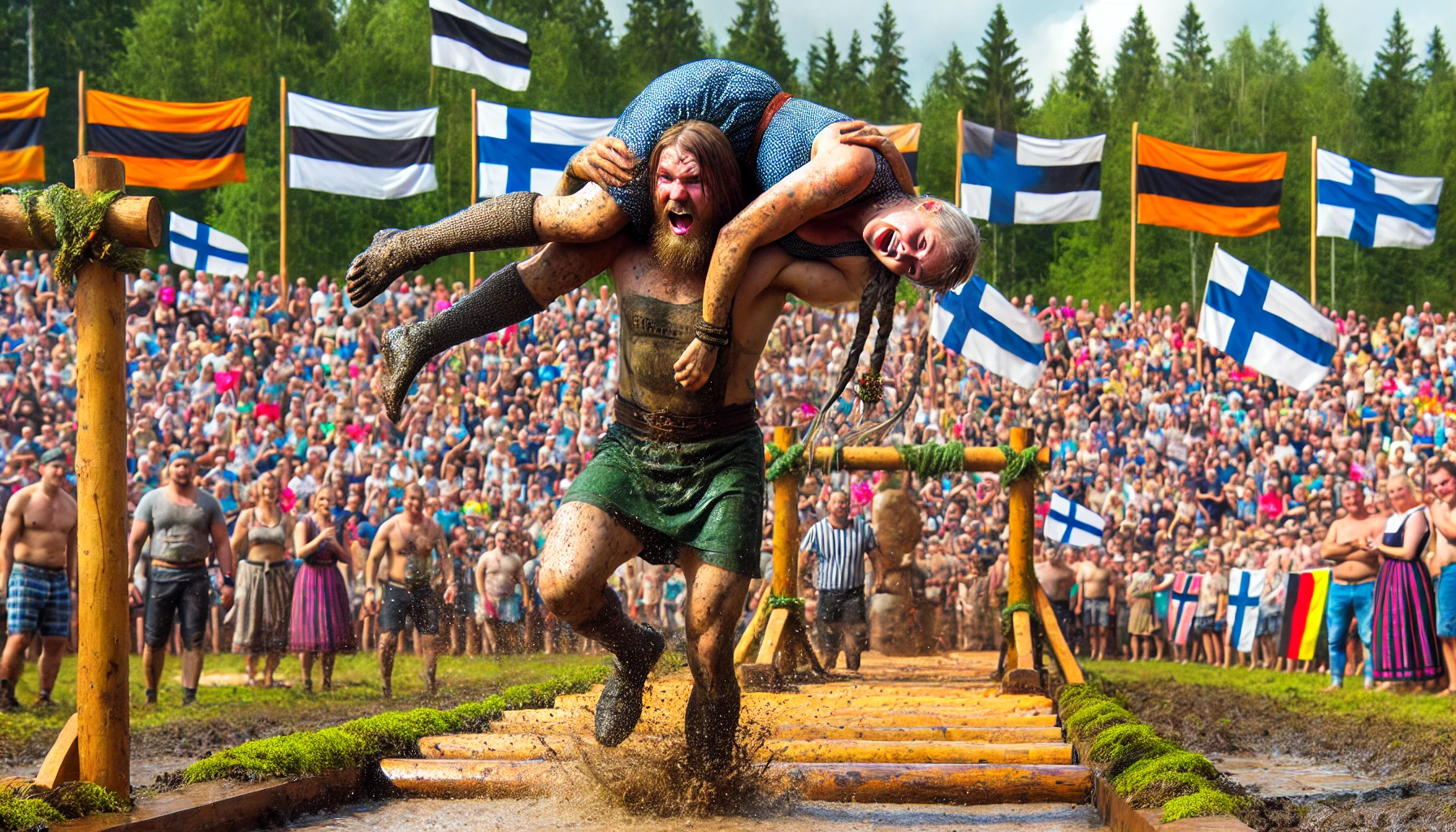
Every year in Finland, a highly unique and somewhat quirky event captures the imagination of participants and spectators alike—the Wife Carrying World Championships. This competition, which is as entertaining as it is demanding, combines physical strength, agility, and a sense of humor, wrapped up in a festival-like atmosphere that celebrates Finnish summer traditions.
Origins of Wife Carrying
The Wife Carrying World Championships, known in Finnish as “eukonkanto,” originated in Sonkajärvi, Finland. The roots of the event are somewhat ambiguous, with some attributing it to an ancient practice where young men would steal women from neighboring villages. This historical context, albeit controversial, has evolved into a consensual and lighthearted competition that attracts competitors from all over the world.
The event has taken place annually since 1992 and has turned into a global phenomenon. The original idea was inspired by the legendary Finnish robber, Herkko Rosvo-Ronkainen, who is said to have tested his gang’s prowess by challenging them to carry heavy sacks on their backs, which eventually evolved into carrying live human beings.
Today, the championship not only promotes sportsmanship and fun but also highlights the Finnish penchant for inventing unusual sporting activities that gain international attention. The competition reflects a blend of historical folklore and modern-day festivity, making it a unique spectacle.
Rules of the Competition
The basic premise of wife carrying is simple: male competitors must carry their female partners through a special obstacle course in the shortest time possible. However, the specific rules and techniques involved make it particularly challenging and amusing for both participants and viewers.
Competitors can choose from several techniques, including the classic piggyback, the fireman’s carry over the shoulder, or the most popular—and visually humorous—Estonian style, where the woman hangs upside-down with her legs around the man’s shoulders, holding onto his waist from behind.
The track is about 253.5 meters long and includes various obstacles, such as water jumps and hurdles. The sport requires not only strength and endurance but also teamwork and strategy, as the couple needs to navigate the course efficiently to win.
The Basic Rules of Wife Carrying
Though wife carrying may seem like a simple race, it follows a set of established rules to ensure a fair and entertaining competition. Understanding these rules is essential for anyone interested in participating in or watching the sport.
1. The Carrying Style is Flexible, but Safety is Paramount
One of the first things to know about wife carrying is that there are no strict guidelines regarding how the wife must be carried. Competitors are free to choose the carrying style that suits them best. However, the most popular and practical style is the “Estonian Carry,” where the wife hangs upside-down with her legs wrapped around the husband’s shoulders and her head near his lower back.
Other carrying styles include the piggyback and fireman’s carry, but these are less common due to their lack of stability. Regardless of the carrying style, safety is always a priority. Both participants must be mindful of their physical abilities to avoid accidents and injuries during the race.
In official competitions, there are often medical personnel on standby to assist in case of an injury. The wife must also wear a helmet for added safety, and both participants should ensure they are comfortable with the selected carry before the event.
2. Minimum Weight and Height Requirements
To ensure fairness in the competition, wife carrying has specific weight and height requirements for participants. The wife must weigh at least 49 kilograms (108 pounds). If she weighs less than this, she must carry an additional weight, such as a backpack filled with sand, to meet the minimum requirement.
This rule prevents an unfair advantage for couples where the wife is significantly lighter, ensuring that the competition is more about the husband’s strength and agility rather than just the wife’s weight. However, there are no minimum weight or height requirements for the husband, allowing men of various sizes and builds to participate.
In addition to weight requirements, participants must be at least 17 years old to compete. This ensures that both the wife and husband have reached physical maturity and are capable of handling the demands of the race.
Popularity and Global Appeal
What started as a small local event has grown into an internationally recognized competition, drawing participants from countries as diverse as Australia, the United States, and Germany. The appeal of the Wife Carrying World Championships lies in its uniqueness and the light-hearted approach to a physically demanding task.
Each year, the event garners significant media coverage, and the number of participants continues to grow. It’s not just about the physical race; the event includes festivities such as music, dancing, and local food, which contribute to its atmosphere of fun and community.
The championship has not only boosted local tourism in Sonkajärvi but also inspired similar events in other countries, creating a global community of enthusiasts who appreciate the blend of humor, sport, and culture that wife carrying offers.
Training and Preparation
Participants take the competition seriously, and many engage in specific training regimes to build the necessary strength and coordination. The key to success in wife carrying is a combination of raw physical strength and practiced technique to handle the course’s challenges effectively.
Couples often train for months in advance, focusing on balance and endurance exercises that improve their ability to tackle the obstacles smoothly. The training also helps in fortifying the couple’s communication and teamwork, crucial elements that go beyond physical preparation.
Moreover, many seasoned competitors experiment with different carrying techniques during practice sessions to find the most efficient method for the race day. This preparation pays off not only in the competition itself but also in strengthening relationships, as couples work together toward a common, albeit unconventional, goal.
The Wife Carrying World Championships exemplify the Finnish spirit of “sisu”—a unique blend of courage, resilience, and determination. This quirky and delightful event is a testament to the creativity and communal spirit of Finland, offering a perfect mix of competition and humor, wrapped up in a culturally rich and physically challenging package.








